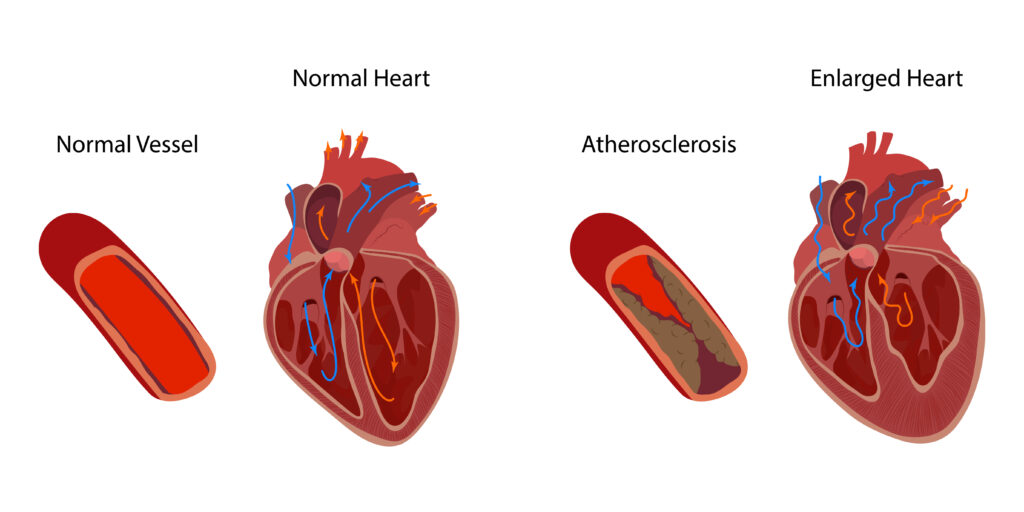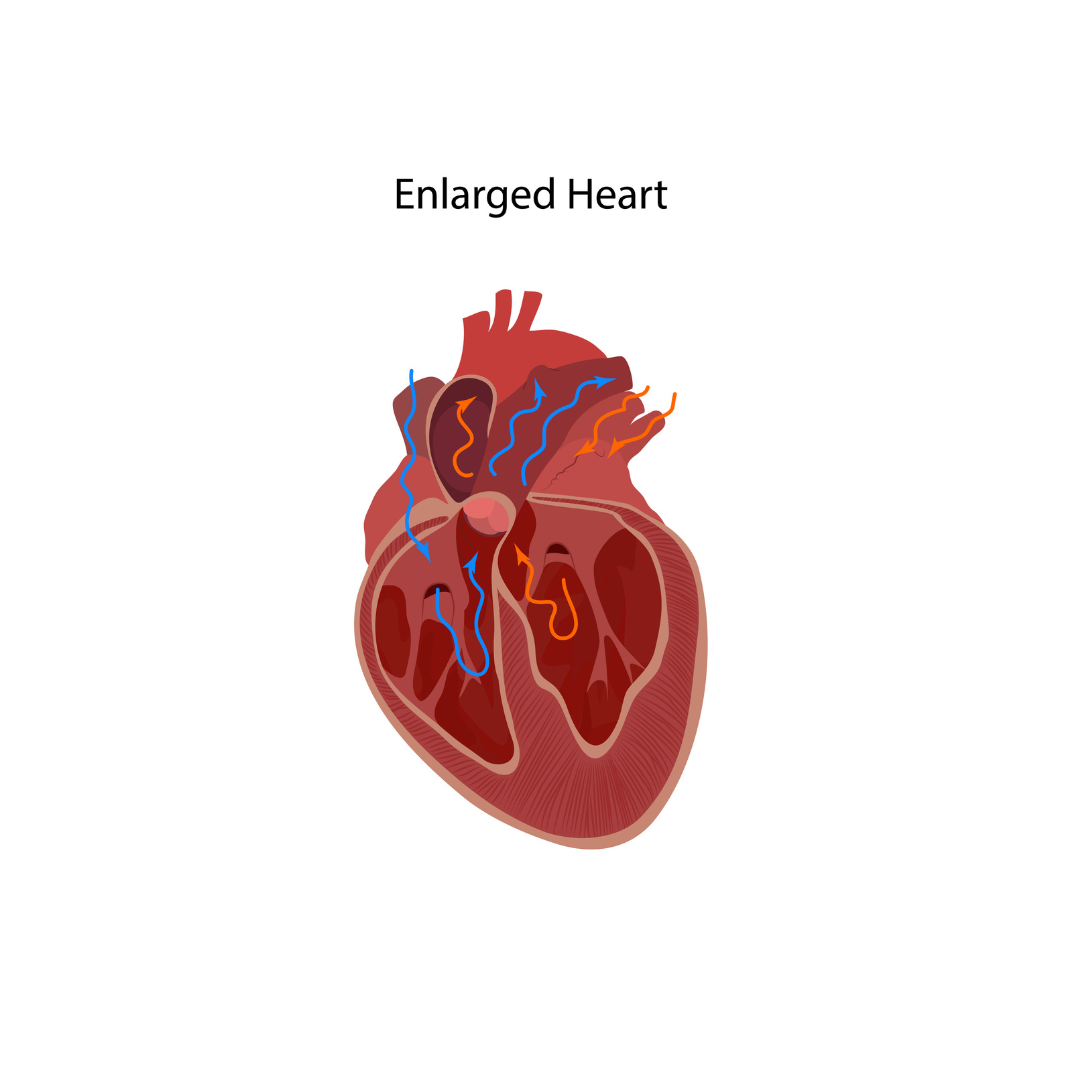An enlarged heart, known as cardiomegaly, is a condition that is more than altered anatomy, it also affects cardiac function and overall health. Recognizing and managing an enlarged heart is important because of its potentially serious implications. In this article, I’ll discuss what an enlarged heart could mean, including symptoms of an enlarged heart, diagnosis, and prevention of complications.
What Causes an Enlarged Heart?
An enlarged heart is often a symptom of an underlying condition, such as:
Hypertension
High blood pressure is the primary cause of an enlarged heart. This is because persistent high blood pressure forces the heart to work harder to pump blood throughout the body. Over time, this increased workload can lead to the enlargement of the left ventricle, the heart’s main pumping chamber, as it adapts to the elevated pressure.
It’s crucial that you know your blood pressure numbers. The goal is to achieve and maintain a blood pressure reading of 120/80 mmHg. If you have high blood pressure, it should be checked at doctors’ visits and monitored at home using a blood pressure cuff. If it is higher than 120/80mmHg, you should work with a Registered Dietitian who specializes in heart disease to help provide proactive implementation strategies to help lower it.
Coronary artery disease (CAD)
CAD occurs when the blood vessels that supply the heart muscle with oxygen and nutrients become narrowed or blocked. Reduced blood flow to the heart can result in damage and enlargement of the affected regions.

Myocarditis
Inflammation of the heart muscle, often caused by viral infections, can result in cardiomegaly. The inflammation can weaken the heart muscle and lead to enlargement.
Arrhythmias
Irregular heart rhythms, such as chronic tachycardia (fast heart rate) or atrial fibrillation, can contribute to an enlarged heart. Arrhythmias may disrupt the heart’s pumping efficiency and lead to muscle enlargement.
Heart valve diseases
Malfunctioning heart valves, such as aortic stenosis or mitral regurgitation, can disrupt normal blood flow within the heart. This can lead to symptoms of an enlarged heart as the chambers compensate.
Chronic anemia
Chronic anemia, a condition characterized by a low red blood cell count, can result in an enlarged heart as it tries to compensate for reduced oxygen-carrying capacity in the blood.
Cardiomyopathies
Cardiomyopathies are a group of conditions where the heart muscle becomes weakened. Dilated cardiomyopathy, in particular, is characterized by an enlarged and weakened heart. Causes can include viral infections, alcohol abuse, genetic factors, and certain medications.
Congenital heart defects
Some individuals are born with structural abnormalities in the heart that can cause it to enlarge over time. These defects may affect the heart chambers, valves, or major blood vessels.
Excessive alcohol consumption
Prolonged, heavy alcohol use can weaken the heart, leading to enlargement. This is known as alcoholic cardiomyopathy.
Obesity
Excess body weight can make it harder for your heart to pump blood normally. This can lead to thickening and enlargement of the heart muscle. Obesity is often associated with conditions like hypertension and diabetes, further contributing to symptoms of an enlarged heart.
Understanding Enlarged Aorta
An enlarged aorta refers to an abnormal dilation or expansion of the aorta, the main artery that carries oxygenated blood from the heart to the rest of the body. The aorta is the largest artery in the body. It is divided into several segments: the ascending aorta, aortic arch, and descending aorta. Enlargement of any of these segments is concerning.
The condition is often referred to as “aortic dilation” or “aortic aneurysm” when the enlargement is significant. An aneurysm is a localized, abnormal bulging or ballooning of a blood vessel wall. It can occur in various arteries, including the aorta.
There are two main types of aortic aneurysms depending on where they’re located:
- Thoracic Aortic Aneurysm: This type involves the segments of the aorta that run through the chest. It can occur in the ascending aorta, aortic arch, or descending aorta within the chest cavity.
- Abdominal Aortic Aneurysm: This type involves the abdominal portion of the aorta, which extends through the abdomen. Abdominal aortic aneurysms are more common than thoracic aortic aneurysms.
Several factors can contribute to the development of an enlarged aorta, including:
- Atherosclerosis: The buildup of fatty deposits and plaque on the inner walls of the aorta. This can weaken and damage the vessel, increasing the risk of aneurysm.
- Genetic Factors: Some individuals may be predisposed to aortic aneurysms, especially if there is a family history.
- Hypertension: High blood pressure can put a strain on the arterial walls, making them more susceptible to dilation and aneurysm formation.
- Connective Tissue Disorders: Certain genetic conditions, like Marfan syndrome and Ehlers-Danlos syndrome, can affect the connective tissues in the body, including those in the aorta.
- Trauma: Injuries or trauma to the chest or abdomen can damage the aorta, potentially causing enlargement.
It’s important to know that some of these risk factors are modifiable, which means you can do things to help address them, alleviate some of the burden on your heart, and ultimately reduce the risk of further complications. For instance, healthy lifestyle changes can help optimize your lipid panels, reduce inflammation, normalize blood pressure levels, and address abdominal obesity.
Symptoms, Diagnosis, and Complications
Symptoms of an enlarged heart may include fatigue, shortness of breath, and swelling in the legs. Recognizing these signs can prompt timely medical intervention, which may include medications or lifestyle adjustments to alleviate symptoms and enhance overall quality of life.
An untreated or undiagnosed enlarged heart may struggle to pump blood effectively. This can lead to serious complications, including arrhythmias, blood clots, heart failure, and sudden cardiac arrest.
Enlarged aortas, on the other hand, can be asymptomatic. If left untreated, an aortic aneurysm can pose a serious risk of rupture, which can be life-threatening.
Monitoring and managing risk factors, regular medical check-ups, and diagnostic imaging (such as ultrasound, CT scans, or MRI) are essential for detecting and managing an enlarged aorta.
Treatment options may include medication, lifestyle modifications, or surgical intervention. The type of treatment will depend on the size, location, and underlying causes of the aneurysm — but preventing complications is key.
Preventing Complications
Now that we’ve covered what causes an enlarged heart, you’re probably wondering what can be done about it. Rather than focusing on the treatment for an enlarged heart, I like to start with how to avoid the progression.
First, have your calcium score checked, which helps identify calcium deposits in your coronary arteries, increasing your risk of a heart attack. Awareness is the first step in reducing your risk factors. From here, you can make changes to optimize your blood lipids and avoid the progression of CAD and other complications.
The best approach is to improve your cardiovascular health by following an anti-inflammatory diet paired with an exercise and stress management plan that helps to address your cardiometabolic burdens on the heart.
Nutrition is imperative to help support a healthy weight, achieve normal blood pressure, and target coronary artery disease, alleviating some of the burden on your heart and tackling risk factors involved in enlarged heart progression.
A heart-healthy diet is based on minimally processed foods such as fruits and vegetables, lean proteins, legumes, nuts, grains, and healthy fats. Consider working with a heart health dietitian who can help come up with a personalized science-based approach.
Enlarged Heart and Aorta: The Takeaway
An enlarged heart or aorta is a potentially life-threatening condition that can result from underlying medical problems. It’s important to understand your risks and monitor your heart health regularly. Practicing healthy habits and eating a nutrient-dense diet are two significant things you can do for your heart.
Not sure where to begin? Book a discovery call with me or consider joining my Heart Health Optimization group.
References
1. Amin H, Siddiqui WJ. Cardiomegaly. [Updated 2022 Nov 20]. In: StatPearls [Internet]. Treasure Island (FL): StatPearls Publishing; 2023 Jan-. Available from: https://www.ncbi.nlm.nih.gov/books/NBK542296/
2. Saheera S, Krishnamurthy P. Cardiovascular Changes Associated with
Hypertensive Heart Disease and Aging. Cell Transplant. 2020;29:963689720920830.
doi:10.1177/0963689720920830
3. Hegde N, Rich MW, Gayomali C. The cardiomyopathy of iron
deficiency. Tex Heart Inst J. 2006;33(3):340-344.
4. Mahmaljy H, Yelamanchili VS, Singhal M. Dilated Cardiomyopathy.
[Updated 2023 Apr 7]. In: StatPearls [Internet]. Treasure Island (FL):
StatPearls Publishing; 2023 Jan-. Available from:
https://www.ncbi.nlm.nih.gov/books/NBK441911/
5. Shaaban A, Gangwani MK, Pendela VS, et al. Alcoholic
Cardiomyopathy. [Updated 2023 Aug 8]. In: StatPearls [Internet]. Treasure
Island (FL): StatPearls Publishing; 2023 Jan-. Available from:
https://www.ncbi.nlm.nih.gov/books/NBK513322/
6. Faiza Z, Sharman T. Thoracic Aorta Aneurysm. [Updated 2023 May 1].
In: StatPearls [Internet]. Treasure Island (FL): StatPearls Publishing; 2023
Jan-. Available from: https://www.ncbi.nlm.nih.gov/books/NBK554567/
7. Shaw PM, Loree J, Gibbons RC. Abdominal Aortic Aneurysm. [Updated
2023 Mar 21]. In: StatPearls [Internet]. Treasure Island (FL): StatPearls
Publishing; 2023 Jan-. Available from:
https://www.ncbi.nlm.nih.gov/books/NBK470237/
8. Grygiel-Górniak B, Oduah MT, Olagunju A, Klokner M. Disorders of
the Aorta and Aortic Valve in Connective Tissue Diseases. Curr Cardiol Rep.
2020;22(8):70. Published 2020 Jun 19. doi:10.1007/s11886-020-01314-0
